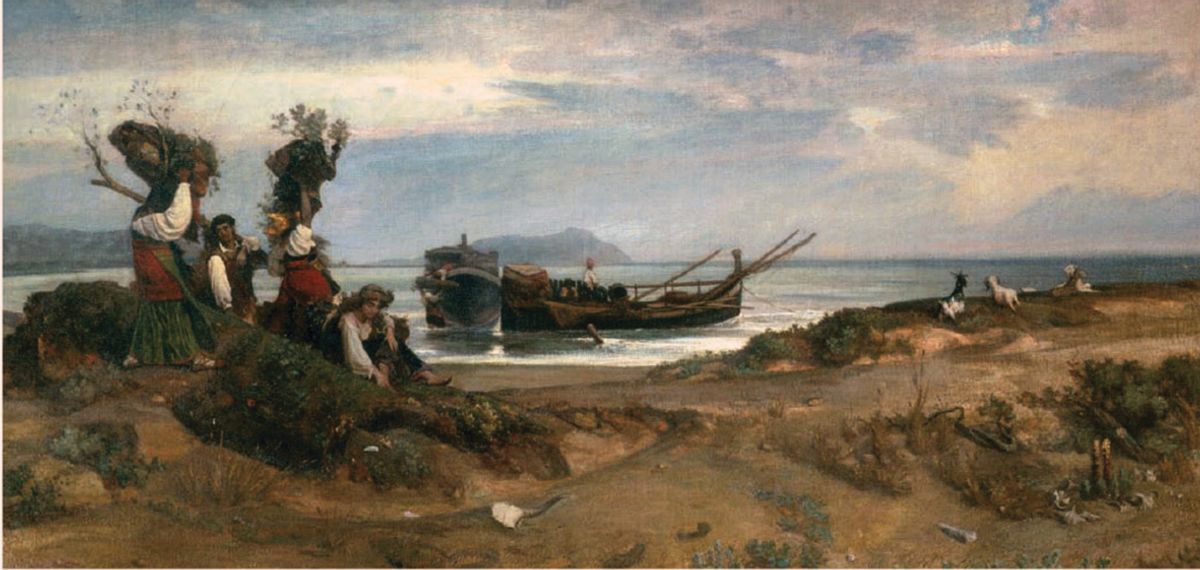Ironically, for a man who threw in his lot with his English artist friends and sold almost exclusively to English patrons, Nino (Giovanni) Costa (1826-1903) is little known and woefully under-represented in English public collections. There are two paintings in the Ashmolean and two in the Victoria Art Gallery in Bath. Obviously he is appreciated by the circle of admirers and collectors of “Etruscan” landscape painting, the name adopted in 1883 by Costa and the group of English artists who were drawn to Costa’s particular vision, and they have not been without exhibitions and scholarly attention. Costa wanted to make his mark in his native country, but he sold only one work in Italy, finding his patrons among the English Aesthetes. He exhibited in London intermittently, at the Royal Academy, the Grosvenor Gallery, the New Gallery and the Fine Art Society, the last, in 1882, a successful monographic show that established his popularity in this country. His biography, published in 1904 and begun during his lifetime and with his co-operation, was by a young Englishwoman, Olivia Rossetti Agresti, niece of Dante Gabriel Rossetti.
Costa was born in Rome in 1826. When he was 21 and a passionate patriot, he joined the “Young Italy” movement, fighting for liberty and the unification of Italy in the 1848 campaign. The Risorgimento had many English supporters and his political stance may have been a factor in his sympathetic reception here. He was to interrupt his artistic career twice more in 1859 and 1870, fighting for the cause. It was after the 1859 campaign that he prudently spent a period living in Florence, a revelation to him of artistic riches. The complex events leading to the unification of Italy in 1870 and Costa’s own participation are outlined in the first chapter, an essential prelude to understanding Costa’s place in modern Italian art and in a broader international context.
He had to leave Rome temporarily in 1849, but was eventually able to return and set up his studio in the Via Margutta. He frequented the Caffè Greco, favoured haunt of artists and writers, among them Frederic Leighton, George Heming Mason and William Blake Richmond in the early 1850s. Edgar Barclay and Walter Crane were influenced by him in the 1870s. He went to Paris, where he met Corot, an important influence, and he spent time in England painting the muted green English countryside, a great contrast to his light-filled Italian scenes. He was sought out by George Howard (later Earl of Carlisle), an aspiring painter, who was to become his most important patron, in Rome in 1865, and who later visited him at Naworth Castle in Cumbria. The formation of this circle was to result in a fruitful period in which Costa produced a number of important works, including his self-proclaimed masterpiece, Women loading wood on boats at Porto d’Anzio (1852). In spite of his best efforts, Costa did not really master the English language.
To Costa’s advantage, many of these new friends were influential in the London art world. Untangling the intricacies of art movements in Italy in the 19th century, not to mention the often obscure byways of French landscape painting beyond the Barbizon and Fontainebleau schools, is no mean feat and it is dealt with here in considerable—and useful—detail.
Living up to the promise of the subtitle, following chapters tackle Costa’s relationship to French and German landscape painting, the lure of Italy for British painters, and Costa’s impact on Italian landscape painting, particularly in relation to the Macchiaioli (with whom he should not be confused), pointing out similarities and differences. Costa is rightly admired for his rigorous approach to al fresco landscape; his attempts at a Leightonesque or French Salon manner cannot be said to be successful and, on the whole, did not attract his English patrons. Costa’s modern admirers have little to say about them.
That this is the most detailed examination of Costa’s career and painting techniques to date is one point, but placing him in the under-researched context of landscape painting across Italy, Britain, France, Switzerland and Germany (the Spanish and Americans in Rome play a more minor role, in the case of the Americans, perhaps a bit of an oversight), tosses up an almost overwhelming plethora of unfamiliar names for further consideration. The question of whether they compare directly with the man Costa or with his landscape innovations is maybe not relevant when the total picture of a genre is convincing.
• Charlotte Gere is a writer, exhibition curator and 19th-century decorative arts specialist, with many publications on jewellery, design and historic interiors, most recently Artistic Circles: Design and Decoration in the Aesthetic Movement (2010) and Jewellery in the Age of Queen Victoria, a Mirror to the World (2010, with Judy Rudoe), winner of the 2011 William M.B. Berger Prize for British Art History
Nino Costa (1826-1903): Transnational Exchange in European Landscape Painting
Arnika Schmidt
Silvana Editoriale/Studi della Bibliotheca Hertziana, No. 10, 256pp, €70 (hb)


